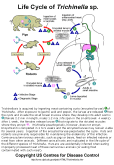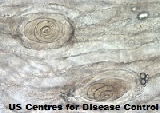|
|
| |
| Causative Agent |
-
Parasitic and
zoonotic disease of carnivorous
mammals and birds caused by infection with the
roundworm, Trichinella spiralis.
|
| Images |
|
Click on images to
enlarge. |
 |
 |
|
Life cycle of
Trichinella. |
Bear muscle showing the
encysted larvae at 200x magnification. |
|
| Distribution |
|
Geographic: |
-
Worldwide, except for Australia and Antarctica.
|
|
Seasonality: |
|
|
|
| Hosts, Transmission and Life
Cycle |
| Hosts: |
-
Primarily a disease of carnivores with scavenging or cannibalistic
tendencies.
-
Several wildlife species in North America are known to be affected,
including bears (Ursidae), wild dogs and cats, pigs
(Suidae), seals (Phocidae, Otariidae), walruses (Odobenus
rosmarus), rodents and
mustelids.
-
Humans can become infected
by T. spiralis by consuming undercooked, infected
meat.
|
|
Generalized Life Cycle: |
-
Refer to the above
generalized life cycle diagram of Trichinella sp.
-
Transmission between hosts
occurs when infected meat is consumed.
-
Cysts
containing larvae are
digested; larvae form
cysts in the inner surface of the
small intestine where they mature into adults and mate.
-
New larvae move via the
bloodstream to muscle where they remain as the infective
stage until eaten by a susceptible carnivore or scavenger.
-
Cysts
may remain in muscle for
6-12 months and can survive after the death of the host, and
so infect scavengers.
|
|
| Signs and Symptoms |
-
Like other adult
roundworms, T. spiralis are unsegmented, cylindrical and
tapered at both ends, and can measure between 1.2 - 2.2
cm in length.
-
In
wildlife, disease can occur at two stages of infection: in the
muscle and in the intestines
-
muscle: muscle pain,
edema,
fever; large burdens of
cysts may
lead to death;
-
intestines: adult worms may cause
hemorrhage.
-
In humans, symptoms such as
edema
around the eyes, muscle pain, fever, diarrhea, itchiness in the
skin, and
lesions of
the skin have been described.
-
More
serious cases in humans have caused
inflammation of the brain, heart failure, and breathing
difficulties as a result of an infected diaphragm.
|
| Meat Edible? |
-
Humans may contract T. spiralis from eating improperly cooked meat
of an infected animal.
-
Meat from an infected animal should not be fed to dogs or cats.
|
| Human Health Concerns and
Risk Reduction |
-
Trichinella
is a
potential
zoonotic
parasite.
-
Infection can be spread to humans through consumption of improperly
cooked meat, especially from bears and seals.
-
To
minimize the chances of infection, meat must be cooked to 77ºC throughout to kill all larvae that may be present.
Microwave ovens do not uniformly cook meat and, as a result, may not
kill the parasite.
-
Freezing meat is NOT a reliable way of killing
Trichinella
roundworms.
-
Several safe and effective prescription drugs are
available to treat trichinellosis. Treatment should begin as soon as
possible and the decision to treat is based upon symptoms, exposure
to raw or undercooked meat, and laboratory test results.
-
Trichinellosis is a
reportable disease in Canada, and under the Health of Animals Act, all cases must
be reported to the Canadian Food Inspection Agency (CFIA).
|
| Samples for Diagnosis |
-
Muscle tissue
containing larval
cysts should be submitted for diagnosis.
-
Cysts may be difficult to see with the naked eye;
however, active muscles such as the tongue, diaphragm and muscles of
the jaw usually contain the highest concentrations of infective
larvae.
|
| Further Reading |
-
Alberta Environment and Sustainable Resource Development – Trichinellosis (PDF file)
-
Alaska Department of Fish and Game – Trichinellosis
-
Appleyard G.D., Gajadhar A.A. 2000. A review of Trichinellosis in
people and wildlife in Canada.
Canadian Journal of Public Health 91: 293-297. (PDF file)
-
Canadian Food Inspection Agency – Trichinellosis (human health)
-
US
Centers for Disease Control and Prevention
– Trichinellosis
(human health)
-
Canadian Cooperative Wildlife Heath Centre. 1995. Trichinosis. Pp. 41-42.
Health Risks to Wildlife
Personnel: Hazards from Disease-causing Agents. Canadian
Cooperative Wildlife Heath Centre, Western College of Veterinary
Medicine, University of Saskatchewan. Saskatoon, SK.
-
Dick T.A., Pozio E. 2001. Trichinella spp. and Trichinellosis. Pp.
380-396 in W.M. Samuel, M.J. Pybus, A.A. Kocan (eds.),
Parasitic Diseases of Wild Mammals. 3rd Ed. Iowa State University
Press, Ames, IA.
-
Elkin B., Zamke R.L. 2001. Common Wildlife Diseases and Parasites in Alaska. Alaska Department
of Fish and Game. Anchorage, AK.
|
|
|




